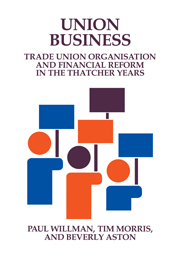Book contents
- Frontmatter
- Contents
- Acknowledgements
- 1 Introduction: unions in the 1980s
- 2 The financial status of British trade unions 1950–1989
- 3 Financial differences between unions
- 4 The role of financial matters in union organisation
- 5 The politics of union finaces
- 6 Union size, growth, and financial performance
- 7 Strike activity and union finances
- 8 The National Union of Mineworkers: strikes and financial disaster
- 9 The GMB: merger and financial reform
- 10 The Amalgamated Engineering Union: back from the brink
- 11 The Banking, Insurance and Finance Union: competitive unionism and financial survival
- 12 The Electrical, Electronic, Telecommunications and Plumbing Trade Union: accountability and financial control
- 13 Conclusions: union business and business unionism
- Appendix 1 Research methods
- Appendix 2 Regression results
- Appendix 3 Questions for finance officers
- Appendix 4 Questions for General Secretaries
- Appendix 5 Questionnaire: trade union finances
- Appendix 6 The number of trade unions
- Notes
- References
- Subject index
- Index of trade unions
- Author index
3 - Financial differences between unions
Published online by Cambridge University Press: 11 March 2010
- Frontmatter
- Contents
- Acknowledgements
- 1 Introduction: unions in the 1980s
- 2 The financial status of British trade unions 1950–1989
- 3 Financial differences between unions
- 4 The role of financial matters in union organisation
- 5 The politics of union finaces
- 6 Union size, growth, and financial performance
- 7 Strike activity and union finances
- 8 The National Union of Mineworkers: strikes and financial disaster
- 9 The GMB: merger and financial reform
- 10 The Amalgamated Engineering Union: back from the brink
- 11 The Banking, Insurance and Finance Union: competitive unionism and financial survival
- 12 The Electrical, Electronic, Telecommunications and Plumbing Trade Union: accountability and financial control
- 13 Conclusions: union business and business unionism
- Appendix 1 Research methods
- Appendix 2 Regression results
- Appendix 3 Questions for finance officers
- Appendix 4 Questions for General Secretaries
- Appendix 5 Questionnaire: trade union finances
- Appendix 6 The number of trade unions
- Notes
- References
- Subject index
- Index of trade unions
- Author index
Summary
Introduction
Differences in financial performance between trade unions have been discussed in previous studies (Roberts, 1956; Latta, 1972; Willman and Morris, 1988). It emerges from all studies that there are both rich and poor, that some unions rely heavily on subscriptions while others live at least in part on investment income and that there is variance both in the subscriptions charged and the services rendered. However, although substantial variance persists, the pattern has altered over time. For example, Latta's dichotomy between poor white-collar and rich manual – industry unions had become blurred by 1985 (Willman and Morris, 1988). The progressive reduction in the number of unions and the concentration of membership in the largest unions (Buchanan, 1981) has influenced the disaggregated pattern of union financial performance.
The objective of this chapter is, firstly, to present the pattern of financial differences between unions in 1989, the last year for which full financial information is currently available and, secondly, to document changes since 1980; we are concerned to understand what lies behind the aggregate picture of recovery in union finances outlined above. There have, within the aggregate picture, been both winners and losers.
The structure of the chapter is as follows. Section 2 looks at the pattern in 1989. Section 3 analyses the pattern of change since 1980. Both sections use data from the set of 56 unions with over 20,000 members in 1984 which was the basis for Willman and Morris (1988). These sections thus update that publication in some respects. Section 4 focuses more closely on the largest unions which account for the bulk both of membership and resources. Section 5 concludes.
- Type
- Chapter
- Information
- Union BusinessTrade Union Organisation and Financial Reform in the Thatcher Years, pp. 20 - 33Publisher: Cambridge University PressPrint publication year: 1993



